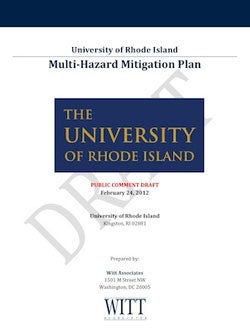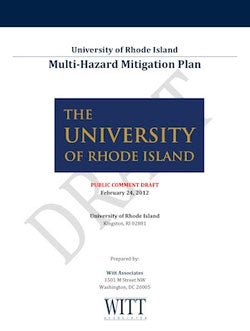 KINGSTON, R.I. — April 3, 2012 — The emergency management task force at the University of Rhode Island is seeking input from faculty, staff, students, community groups, public safety departments and local governments on a multi-hazard mitigation plan it has put together.
KINGSTON, R.I. — April 3, 2012 — The emergency management task force at the University of Rhode Island is seeking input from faculty, staff, students, community groups, public safety departments and local governments on a multi-hazard mitigation plan it has put together.
The plan identifies known threats and hazards that could affect the campus and steps that can be taken to mitigate potential damages resulting from those threats. It outlines actions that can be taken to reduce long-term risk to the University.
The task force is comprised of officials from the URI Department of Public Safety (including police and Emergency Management/Homeland Security), URI Emergency Medical Services and the Kingston Fire District, as well as non-traditional emergency responders from groups including Health Services, Communications and Marketing, Facilities Services, Housing and Residential Life and Dining Services.
Once implemented, the plan would bring the University into compliance with the Federal Emergency Management Agency’s Hazard Mitigation Planning Program. That would open the door for the University to receive funding from FEMA to address these hazards.
The hazard mitigation plan is being conducted as part of a program initiated by a $704,000 grant from the U.S. Department of Education to update and improve the University’s preparedness, response, mitigation and recovery from potential crises.
Shad Ahmed, URI’s emergency management and homeland security coordinator, said the task force has been working on the plan for at least six months.
“The task force has been looking at threats and hazards the campus could face and came up with what it thinks are the primary hazards facing URI,” said Ahmed, who is also the director of the University’s National Institute for Public Safety Research and Training. “All sorts of hazards can affect the campus, and the job was to prioritize them and determine which are most likely to occur.”
The plan includes ways to mitigate the effects of hazards such as severe weather (blizzards, hurricanes, tornadoes), disease outbreaks and pandemics, nuclear reactor hazards and more.
The task force also hired Witt Associates ¬ founded by James Lee Witt, the former administrator of FEMA under President Bill Clinton — to help identify such threats and craft some of the more technical aspects of the plan, Ahmed said.
With all the work put in by the task force to craft the plan, Ahmed said input from the surrounding communities and civic groups is vital because so many people have a stake in how the University responds to potential disasters.
“It’s a collaborative process and our plan was drafted by our people for our constituents and our community,” Ahmed said.
Specifically, the task force needs to get comments from:
• Faculty, staff, students and visitors to the University
• City/town emergency management officials for all campus areas
• Any major vendors or contractors who regularly visit the campuses, or who would have an interest in the University’s risk and vulnerability
• Any other state/federal agencies with whom the University has relationships (i.e., NOAA, etc);
• Any neighborhood associations or civic groups that are active near the campuses
• Any non-profit groups that are active near the campuses
Anyone who wishes to review the plan can view it at http://www.uri.edu/news/download/HMP and comments can be sent to plan@emergency.uri.edu. The public comment period will be open until April 17.

